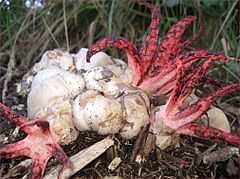Clathrus archeri
| Octopus Stinkhorn | |
|---|---|
 | |
| Octopus Stinkhorn (Clathrus archeri) with suberumpent eggs | |
| Conservation status | |
| uncommon | |
| Scientific classification | |
| Kingdom: | Fungi |
| Division: | Basidiomycota |
| Class: | Agaricomycetes |
| Order: | Phallales |
| Family: | Phallaceae |
| Genus: | Clathrus |
| Species: | C. archeri |
| Binomial name | |
| Clathrus archeri (Berk.) Dring 1980 | |
| Clathrus archeri | |
|---|---|
|
| |
| glebal hymenium | |
| no distinct cap | |
| hymenium attachment is irregular or not applicable | |
| lacks a stipe | |
| spore print is olive-brown | |
| ecology is saprotrophic | |
| edibility: inedible | |
Clathrus archeri (synonyms Lysurus archeri, Anthurus archeri, Pseudocolus archeri), commonly known as Octopus Stinkhorn, is indigenous to Australia and Tasmania and an introduced species in Europe, North America and Asia. The young fungus erupts from a suberumpent egg by forming into four to seven elongated slender arms initially erect and attached at the top. The arms then unfold to reveal a pinkish-red interior covered with a dark-olive spore-containing gleba. In maturity it smells of putrid flesh. Recently, C. archeri var. alba with white tentacles or arms has been reported from the shola forests in the Western Ghats, Kerala, India.[1]
Habitat
It is found gregarious to clustered in moist, shaded meadows and deciduous or mixed forests during July to September.
Dissemination
The pinkish-red color and fetid odour of the ripe fungus is thought to resemble decaying flesh and thereby attracting flies which unwittingly spread the gleba and thus the species.
Edibility
The Octopus Stinkhorn is edible, but its taste is extremely foul. The eggs of this fungus taste and smell like radish and are the only edible stage. It should only be eaten in a wilderness survival circumstance when no other food is available. In other cases, it is considered inedible.
-

An Octopus Stinkhorn spotted in Kalmthout
-
An Octopus Stinkhorn spotted in Şuncuiuş
-

An Octopus Stinkhorn in Namadgi National Park, Australia
-

An Octopus Stinkhorn in Namadgi National Park, Australia
References
- Arora, D & WR Burk (1982) Clathrus archeri, a Stinkhorn New to North America, Mycologia 74. pp. 501-504.
- Calonge, Francisco D. (1998) Gasteromycetes, I. Lycoperdales, Nidulariales, Phallales, Sclerodermatales, Tulostomatale in Flora Mycologica Iberica, Vol 3, J Cramer, Berlin, Germany. p. 271.
- Dring, DM (1980) Contributions towards a rational arrangement of the Clathraceae, Royal Botanic Gardens, Kew, Surrey, England. p. 96.
- Pegler, DN et al. (1995) British Puffballs, Earthstars, and Stinkhorns, Royal Botanic Gardens, Kew, England. p. 255.
